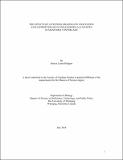| dc.contributor.author | Rodgers, Jessica Lynne | |
| dc.date.accessioned | 2018-09-11T16:43:09Z | |
| dc.date.available | 2018-09-11T16:43:09Z | |
| dc.date.issued | 2018-07 | |
| dc.identifier.citation | Rodgers, Jessica Lynne. The effects of Livestock Grazing on Vegetation and Lepidopterans in Endangered Alvar Sites in Manitoba's Interlake: A thesis submitted to the Faculty of Graduate Studies in partial fulfillment of the requirements for the Masters of Science degree. Winnipeg, Manitoba, Canada: University of Winnipeg, 2018. | en_US |
| dc.identifier.uri | http://hdl.handle.net/10680/1569 | |
| dc.description.abstract | Alvar is a rare type of ecosystem characterized by open, flat terrain and incomplete vegetation intermixed with patches of exposed calcareous pavement. Alvars in Manitoba’s Interlake support tall grass prairie and boreal forest species that do not grow together in any other ecosystem and thus alvars make a unique contribution to biodiversity. The Interlake region is sparsely populated and the dominant land uses are mining and agriculture and livestock grazing is prevalent in alvar areas with thin soils that are not suitable for crop agriculture. Disturbances including grazing may be necessary to maintain alvar plant communities by removing encroaching shrubs and trees, which is beneficial, however grazing may also have negative effects. Studies using bioindicator species to reflect the impacts of disturbance can signal future ecological changes, and indicate areas sensitive to disturbance. I hypothesized that there would be differences in environmental conditions, and in plant and Lepidopteran diversity between grazed and ungrazed sites. Assessment of soil variables showed that soils in grazed sites were significantly more compacted and higher in nitrate and sodium than soils in ungrazed sites. Plant species richness was significantly higher in the ungrazed sites, likely as a result of encroaching forests and soil factors. Ungrazed sites supported a variety of shade-tolerant plant species, while the grazed sites were associated with shade-intolerant and grazing-tolerant/unpalatable species. The butterflies appeared to be more closely associated to the presence of their larval and nectar hosts in alvars, and moths are likely using surrounding forests for food resources. The best management strategy is for grazing to be maintained at a low intensity, and begin later in the season to maximize plant regeneration and access to nectar resources. | en_US |
| dc.description.sponsorship | Manitoba Sustainable Development Wildlife Branch | en_US |
| dc.language.iso | en | en_US |
| dc.publisher | University of Winnipeg | en_US |
| dc.rights | info:eu-repo/semantics/openAccess | |
| dc.subject | Ecology | en_US |
| dc.subject | Conservation | en_US |
| dc.subject | Entomology | en_US |
| dc.subject | Biology | en_US |
| dc.subject | Lepidoptera | en_US |
| dc.subject | Plants | en_US |
| dc.subject | Management | en_US |
| dc.subject | Grazing | en_US |
| dc.subject | Alvar | en_US |
| dc.title | The effects of Livestock Grazing on Vegetation and Lepidopterans in Endangered Alvar Sites in Manitoba's Interlake: A thesis submitted to the Faculty of Graduate Studies in partial fulfillment of the requirements for the Masters of Science degree | en_US |
| dc.type | Thesis | en_US |
| dc.description.degree | Master of Science in BioScience, Technology, and Public Policy | en_US |
| dc.publisher.grantor | University of Winnipeg | en_US |
| thesis.degree.discipline | BioScience, Technology, and Public Policy | |
| thesis.degree.level | masters | |
| thesis.degree.name | Master of Science in BioScience, Technology, and Public Policy | |
| thesis.degree.grantor | University of Winnipeg | |

